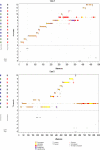Problems and processes in medical encounters: the cases method of dialogue analysis
- PMID: 23391684
- PMCID: PMC3622168
- DOI: 10.1016/j.pec.2012.12.012
Problems and processes in medical encounters: the cases method of dialogue analysis
Abstract
Objective: To develop methods to reliably capture structural and dynamic temporal features of clinical interactions.
Methods: Observational study of 50 audio-recorded routine outpatient visits to HIV specialty clinics, using innovative analytic methods. The comprehensive analysis of the structure of encounters system (CASES) uses transcripts coded for speech acts, then imposes larger-scale structural elements: threads--the problems or issues addressed; and processes within threads--basic tasks of clinical care labeled presentation, information, resolution (decision making) and Engagement (interpersonal exchange). Threads are also coded for the nature of resolution.
Results: 61% of utterances are in presentation processes. Provider verbal dominance is greatest in information and resolution processes, which also contain a high proportion of provider directives. About half of threads result in no action or decision. Information flows predominantly from patient to provider in presentation processes, and from provider to patient in information processes. Engagement is rare.
Conclusions: In this data, resolution is provider centered; more time for patient participation in resolution, or interpersonal engagement, would have to come from presentation.
Practice implications: Awareness of the use of time in clinical encounters, and the interaction processes associated with various tasks, may help make clinical communication more efficient and effective.
Copyright © 2013 Elsevier Ireland Ltd. All rights reserved.
Figures
References
-
- Kaplan SH, Gandek B, Greenfield S, Rogers W, Ware JE. Patient and visit characteristics related to physicians’ participatory decision-making style. Results from the Medical Outcomes Study. Medical Care. 1995;33(12):1176–87. - PubMed
-
- Roter DL, Stewart M, Putnam SM, Lipkin M, Jr., Stiles W, Inui TS. Communication patterns of primary care physicians. JAMA. 1997;277(4):350–6. - PubMed
-
- Bertakis KD, Roter D, Putnam SM. The relationship of physician medical interview style to patient satisfaction. J FamPract. 1991;32(2):175–81. - PubMed
-
- Levinson W, Roter DL, Mullooly JP, Dull VT, Frankel RM. Physician-patient communication. The relationship with malpractice claims among primary care physicians and surgeons. JAMA. 1997;277(7):553–9. - PubMed
-
- Hall JA, Roter DL, Katz NR. Meta-analysis of correlates of provider behavior in medical encounters. Medical Care. 1988;26(7):657–75. - PubMed
MeSH terms
Grants and funding
LinkOut - more resources
Full Text Sources
Other Literature Sources
Medical


